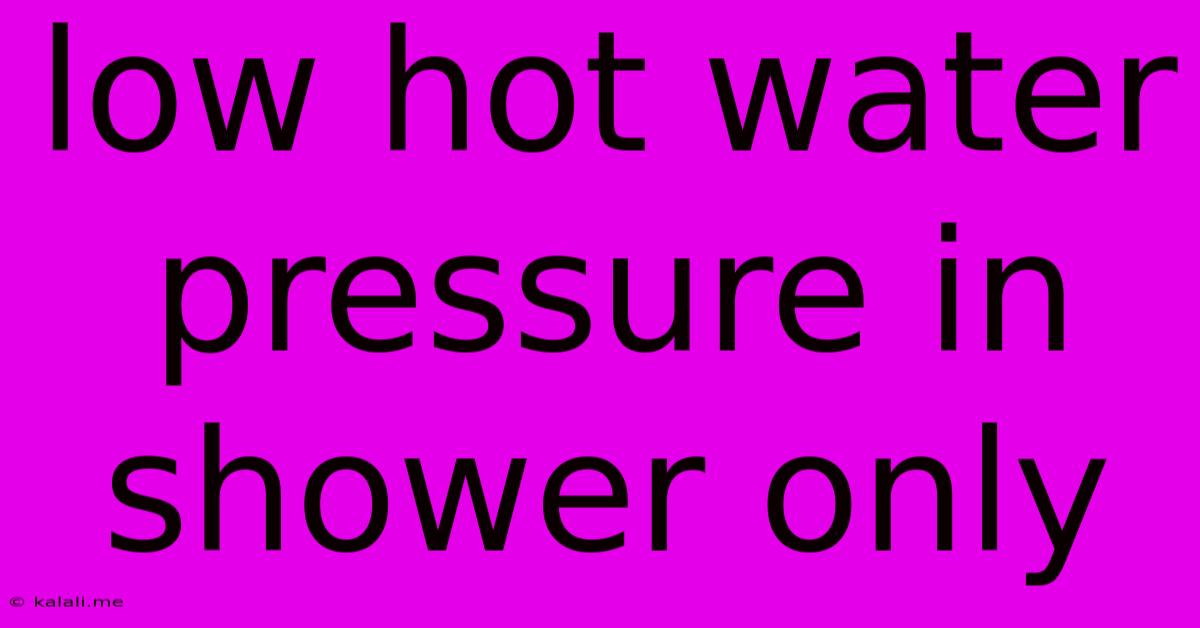Low Hot Water Pressure In Shower Only
Kalali
May 30, 2025 · 4 min read

Table of Contents
Low Hot Water Pressure in Shower Only: Troubleshooting and Solutions
Are you experiencing frustratingly low hot water pressure only in your shower? This common plumbing problem can be annoying, but thankfully, it's often solvable with some DIY troubleshooting. This article will guide you through the potential causes and solutions, helping you regain that invigorating, high-pressure shower you deserve. We'll cover everything from simple checks to more complex repairs, so let's dive in!
Why is my hot water pressure low only in the shower? This issue isn't usually due to a general lack of water pressure throughout your home. Instead, it typically points to a problem isolated to your shower's plumbing system. Several factors could be at play:
1. Mineral Buildup and Sedimentation:
Over time, minerals in your water can accumulate in the showerhead and pipes, restricting water flow. This is especially common in areas with hard water. Lime scale and other mineral deposits narrow the pipes' diameter, leading to reduced pressure. Sediment can also clog the showerhead's spray nozzles, further diminishing the pressure.
- Solution: Regularly cleaning your showerhead is crucial. Soak it in a solution of white vinegar and water to dissolve mineral deposits. You can also use a commercial descaling solution. For more stubborn buildup, you might need to use a small brush or needle to clear clogged spray holes. A thorough cleaning of the showerhead often resolves this issue.
2. Faulty Showerhead:
A damaged or clogged showerhead is a common culprit. Restricted spray nozzles from mineral buildup, internal clogging, or a faulty design can all significantly reduce water pressure. Additionally, a low-flow showerhead, though water-efficient, might inherently provide lower pressure than a standard one.
- Solution: Try replacing your showerhead with a new one. This is a relatively inexpensive and easy fix. Choose a showerhead with a higher flow rate if you desire a stronger stream. Ensure the new showerhead is compatible with your shower arm's connections.
3. Clogged Shower Arm or Pipe:
The pipe leading to your showerhead (the shower arm) can become clogged with sediment or debris over time, reducing water flow. This is especially true if you have older plumbing. Similar clogging can also occur further back in your hot water lines, specifically impacting only the shower.
- Solution: This requires a more involved approach. You may need to access the shower arm and clean it thoroughly or replace it entirely if the clog is severe. If the blockage is further back in the piping, it's best to call a qualified plumber.
4. Problem with the Hot Water Heater:
While less common if other faucets have good pressure, a malfunctioning hot water heater could be at play. Low water pressure in the hot water heater itself could affect only hot water outlets. Issues like sediment buildup in the tank, a faulty pressure relief valve, or a failing heating element can lead to decreased water pressure.
- Solution: Check your hot water heater's pressure gauge. If it's too low, you may need to drain and flush the tank to remove sediment. If the problem persists, you might need to replace the valve or heating element, or potentially even the entire hot water heater— a task best left to a professional.
5. Water Pressure Regulator Issues:
A faulty or improperly adjusted water pressure regulator can restrict water flow to certain parts of your home, including your shower. This is less likely to affect only the hot water, but it's a possibility.
- Solution: Inspecting your water pressure regulator is best left to a professional plumber. They can determine if it needs adjustment or replacement.
When to Call a Plumber:
If you've tried the above troubleshooting steps and still have low hot water pressure only in your shower, it's time to call a qualified plumber. They have the expertise and tools to diagnose more complex issues, such as internal pipe blockages or problems with your home's plumbing system.
By systematically investigating these potential causes, you can effectively troubleshoot and resolve low hot water pressure in your shower, restoring the enjoyment of a powerful and refreshing shower experience. Remember safety first—if you're uncomfortable working with plumbing, always consult a professional.
Latest Posts
Latest Posts
-
How To Connect A 3 Way Switch
May 31, 2025
-
How To Fix Too Much Pepper In Soup
May 31, 2025
-
Thank You So Much Or Very Much
May 31, 2025
-
How Old Was Solomon When He Asked For Wisdom
May 31, 2025
-
Converting From Twos Complement To Decimal
May 31, 2025
Related Post
Thank you for visiting our website which covers about Low Hot Water Pressure In Shower Only . We hope the information provided has been useful to you. Feel free to contact us if you have any questions or need further assistance. See you next time and don't miss to bookmark.